Carboxyl-Functionalized Polymeric Microspheres Prepared by One-Stage Photoinitiated RAFT Dispersion Polymerization
Abstract
:1. Introduction
2. Experimental Section
2.1. Materials
2.2. Characterization
2.3. Photoinitiated RAFT Dispersion Polymerization of MMA and MAA
2.4. Synthesis of Ag Composite Microspheres
2.5. Catalytic Reduction of Methylene Blue (MB)
3. Results and Discussion
3.1. Photoinitiated RAFT Dispersion Copolymerization of MMA and MAA
3.2. Effect of RAFT Agent Concentration
3.3. Effect of Photoinitiator Concentration
3.4. Effect of Stabilizer Concentration
3.5. Effect of Solvent Composition
3.6. Quantification of Carboxyl Groups on the Particle Surface
3.7. Synthesis of Organic/Inorganic Composite Microspheres
4. Conclusions
Supplementary Materials
Acknowledgments
Author Contributions
Conflicts of Interest
References
- Kawaguchi, H. Functional polymer microspheres. Prog. Polym. Sci. 2000, 25, 1171–1210. [Google Scholar] [CrossRef]
- Tan, J.; Zhao, G.; Zeng, Z.; Winnik, M.A. PMMA Microspheres with Embedded Lanthanide Nanoparticles by Photoinitiated Dispersion Polymerization with a Carboxy-Functional Macro-RAFT Agent. Macromolecules 2015, 48, 3629–3640. [Google Scholar] [CrossRef]
- Tan, J.; Peng, Y.; Liu, D.; Huang, C.; Yu, M.; Jiang, D.; Zhang, L. Facile Preparation of Monodisperse Poly(2-hydroxyethyl acrylate)-Grafted Poly(methyl methacrylate) Microspheres via Photoinitiated RAFT Dispersion Polymerization. Macromol. Chem. Phys. 2016, 217, 1723–1728. [Google Scholar] [CrossRef]
- Tan, J.; Fu, L.; Zhang, X.; Bai, Y.; Zhang, L. Photosynthesis of poly(glycidyl methacrylate) microspheres: A component for making covalently cross-linked colloidosomes and organic/inorganic nanocomposites. J. Mater. Sci. 2016, 51, 9455–9471. [Google Scholar] [CrossRef]
- Přikryl, P.; Horák, D.; Tichá, M.; Kučerová, Z. Magnetic IDA-modified hydrophilic methacrylate-based polymer microspheres for IMAC protein separation. J. Sep. Sci. 2006, 29, 2541–2549. [Google Scholar] [CrossRef] [PubMed]
- Zhang, Y.; Li, D.; Yu, M.; Ma, W.; Guo, J.; Wang, C. Fe3O4/PVIM-Ni2+ Magnetic Composite Microspheres for Highly Specific Separation of Histidine-Rich Proteins. ACS Appl. Mater. Interfaces 2014, 6, 8836–8844. [Google Scholar] [CrossRef] [PubMed]
- Ugelstad, J.; Kaggerud, K.H.; Hansen, F.K.; Berge, A. Absorption of low molecular weight compounds in aqueous dispersions of polymer-oligomer particles, 2. A two step swelling process of polymer particles giving an enormous increase in absorption capacity. Makromol. Chem. 1979, 180, 737–744. [Google Scholar] [CrossRef]
- Bradford, E.B.; Vanderhoff, J.W. Electron Microscopy of Monodisperse Latexes. J. Appl. Phys. 1955, 26, 864–871. [Google Scholar] [CrossRef]
- Kawaguchi, S.; Ito, K. Dispersion Polymerization. In Polymer Particles; Okubo, M., Ed.; Advances in Polymer Science; Springer: Berlin, Germany, 2005; pp. 299–328. [Google Scholar]
- Abdelrahman, A.I.; Dai, S.; Thickett, S.C.; Ornatsky, O.; Bandura, D.; Baranov, V.; Winnik, M.A. Lanthanide-Containing Polymer Microspheres by Multiple-Stage Dispersion Polymerization for Highly Multiplexed Bioassays. J. Am. Chem. Soc. 2009, 131, 15276–15283. [Google Scholar] [CrossRef] [PubMed]
- Tan, J.; Rao, X.; Yang, J.; Zeng, Z. Synthesis of Highly Monodisperse Surface-Functional Microspheres by Photoinitiated RAFT Dispersion Polymerization Using Macro-RAFT Agents. Macromolecules 2013, 46, 8441–8448. [Google Scholar] [CrossRef]
- Lee, H.J.; Cho, W.; Oh, M. Advanced fabrication of metal-organic frameworks: Template-directed formation of polystyrene@ZIF-8 core-shell and hollow ZIF-8 microspheres. Chem. Commun. 2011, 48, 221–223. [Google Scholar] [CrossRef] [PubMed]
- Chen, M.; Xie, L.; Li, F.; Zhou, S.; Wu, L. Capillary-Force-Induced Formation of Luminescent Polystyrene/(Rare-Earth-Doped Nanoparticle) Hybrid Hollow Spheres. ACS Appl. Mater. Interfaces 2010, 2, 2733–2737. [Google Scholar] [CrossRef] [PubMed]
- Song, J.-S.; Chagal, L.; Winnik, M.A. Monodisperse Micrometer-Size Carboxyl-Functionalized Polystyrene Particles Obtained by Two-Stage Dispersion Polymerization. Macromolecules 2006, 39, 5729–5737. [Google Scholar] [CrossRef]
- Song, S.; Zhang, W.; Hu, Z.; Zhang, Z. Monodisperse micrometer-size carboxyl-functionalized polystyrene particles obtained by two-stage radiation-induced dispersion polymerization. Colloids Surf. Physicochem. Eng. Asp. 2009, 348, 1–8. [Google Scholar] [CrossRef]
- Song, J.-S.; Tronc, F.; Winnik, M.A. Two-Stage Dispersion Polymerization toward Monodisperse, Controlled Micrometer-Sized Copolymer Particles. J. Am. Chem. Soc. 2004, 126, 6562–6563. [Google Scholar] [CrossRef] [PubMed]
- Song, J.-S.; Winnik, M.A. Cross-Linked, Monodisperse, Micron-Sized Polystyrene Particles by Two-Stage Dispersion Polymerization. Macromolecules 2005, 38, 8300–8307. [Google Scholar] [CrossRef]
- Song, J.-S.; Winnik, M.A. Monodisperse, Micron-Sized Reactive Low Molar Mass Polymer Microspheres by Two-Stage Living Radical Dispersion Polymerization of Styrene. Macromolecules 2006, 39, 8318–8325. [Google Scholar] [CrossRef]
- Tan, J.; Rao, X.; Wu, X.; Deng, H.; Yang, J.; Zeng, Z. Photoinitiated RAFT Dispersion Polymerization: A Straightforward Approach toward Highly Monodisperse Functional Microspheres. Macromolecules 2012, 45, 8790–8795. [Google Scholar] [CrossRef]
- Tan, J.; Rao, X.; Jiang, D.; Yang, J.; Zeng, Z. One-stage photoinitiated RAFT dispersion polymerization–Reaction parameters for achieving high particle size uniformity. Polymer 2014, 55, 2380–2388. [Google Scholar] [CrossRef]
- Tan, J.; Rao, X.; Yang, J.; Zeng, Z. Monodisperse highly cross-linked “living” microspheres prepared via photoinitiated RAFT dispersion polymerization. RSC Adv. 2015, 5, 18922–18931. [Google Scholar] [CrossRef]
- Lai, J.T.; Filla, D.; Shea, R. Functional Polymers from Novel Carboxyl-Terminated Trithiocarbonates as Highly Efficient RAFT Agents. Macromolecules 2002, 35, 6754–6756. [Google Scholar] [CrossRef]
- Warren, N.J.; Armes, S.P. Polymerization-Induced Self-Assembly of Block Copolymer Nano-objects via RAFT Aqueous Dispersion Polymerization. J. Am. Chem. Soc. 2014, 136, 10174–10185. [Google Scholar] [CrossRef] [PubMed]
- Canning, S.L.; Smith, G.N.; Armes, S.P. A Critical Appraisal of RAFT-Mediated Polymerization-Induced Self-Assembly. Macromolecules 2016, 49, 1985–2001. [Google Scholar] [CrossRef] [PubMed]
- Sun, J.-T.; Hong, C.-Y.; Pan, C.-Y. Recent advances in RAFT dispersion polymerization for preparation of block copolymer aggregates. Polym. Chem. 2013, 4, 873–881. [Google Scholar] [CrossRef]
- Tan, J.; Bai, Y.; Zhang, X.; Huang, C.; Liu, D.; Zhang, L. Low-Temperature Synthesis of Thermoresponsive Diblock Copolymer Nano-Objects via Aqueous Photoinitiated Polymerization-Induced Self-Assembly (Photo-PISA) using Thermoresponsive Macro-RAFT Agents. Macromol. Rapid Commun. 2016. [Google Scholar] [CrossRef] [PubMed]
- Tan, J.; Huang, C.; Liu, D.; Li, X.; He, J.; Xu, Q.; Zhang, L. Polymerization-Induced Self-Assembly of Homopolymer and Diblock Copolymer: A Facile Approach for Preparing Polymer Nano-Objects with Higher-Order Morphologies. ACS Macro Lett. 2017, 6, 298–303. [Google Scholar] [CrossRef]
- Tan, J.; Liu, D.; Bai, Y.; Huang, C.; Li, X.; He, J.; Xu, Q.; Zhang, L. Enzyme-Assisted Photoinitiated Polymerization-Induced Self-Assembly: An Oxygen-Tolerant Method for Preparing Block Copolymer Nano-Objects in Open Vessels and Multiwell Plates. Macromolecules 2017, 50, 5798–5806. [Google Scholar] [CrossRef]
- Tan, J.; Liu, D.; Huang, C.; Li, X.; He, J.; Xu, Q.; Zhang, L. Photoinitiated Polymerization-Induced Self-Assembly of Glycidyl Methacrylate for the Synthesis of Epoxy-Functionalized Block Copolymer Nano-Objects. Macromol. Rapid Commun. 2017, 38, 1–7. [Google Scholar] [CrossRef] [PubMed]
- Tan, J.; He, J.; Li, X.; Xu, Q.; Huang, C.; Liu, D.; Zhang, L. Rapid synthesis of well-defined all-acrylic diblock copolymer nano-objects via alcoholic photoinitiated polymerization-induced self-assembly (photo-PISA). Polym. Chem. 2017, 8, 6853–6864. [Google Scholar] [CrossRef]
- Tan, J.; Liu, D.; Zhang, X.; Huang, C.; He, J.; Xu, Q.; Li, X.; Zhang, L. Facile preparation of hybrid vesicles loaded with silica nanoparticles via aqueous photoinitiated polymerization-induced self-assembly. RSC Adv. 2017, 7, 23114–23121. [Google Scholar] [CrossRef]
- Huang, C.; Tan, J.; Xu, Q.; He, J.; Li, X.; Liu, D.; Zhang, L. Adding a solvophilic comonomer to the polymerization-induced self-assembly of block copolymer and homopolymer: A cooperative strategy for preparing large compound vesicles. RSC Adv. 2017, 7, 46069–46081. [Google Scholar] [CrossRef]
- Medina-Castillo, A.L.; Fernandez-Sanchez, J.F.; Segura-Carretero, A.; Fernandez-Gutierrez, A. Micrometer and Submicrometer Particles Prepared by Precipitation Polymerization: Thermodynamic Model and Experimental Evidence of the Relation between Flory’s Parameter and Particle Size. Macromolecules 2010, 43, 5804–5813. [Google Scholar] [CrossRef]
- Paine, A.J. Dispersion polymerization of styrene in polar solvents. 7. A simple mechanistic model to predict particle size. Macromolecules 1990, 23, 3109–3117. [Google Scholar] [CrossRef]
- D’hooge, D.R.; Van Steenberge, P.H.M.; Reyniers, M.-F.; Marin, G.B. The strength of multi-scale modeling to unveil the complexity of radical polymerization. Prog. Polym. Sci. 2016, 58, 59–89. [Google Scholar] [CrossRef]
- Saikia, P.J.; Lee, J.M.; Lee, K.; Choe, S. Reaction parameters in the RAFT mediated dispersion polymerization of styrene. J. Polym. Sci. A Polym. Chem. 2008, 46, 872–885. [Google Scholar] [CrossRef]
- Chen, J.; Zeng, Z.; Yang, J.; Chen, Y. Photoinitiated dispersion polymerization of methyl methacrylate: A quick approach to prepare polymer microspheres with narrow size distribution. J. Polym. Sci. A Polym. Chem. 2008, 46, 1329–1338. [Google Scholar] [CrossRef]
- Fielding, L.A.; Tonnar, J.; Armes, S.P. All-Acrylic Film-Forming Colloidal Polymer/Silica Nanocomposite Particles Prepared by Aqueous Emulsion Polymerization. Langmuir 2011, 27, 11129–11144. [Google Scholar] [CrossRef] [PubMed]
- Gao, R.; Zhou, S.; Chen, M.; Wu, L. Facile synthesis of monodisperse meso-microporous Ta3N5 hollow spheres and their visible light-driven photocatalytic activity. J. Mater. Chem. 2011, 21, 17087–17090. [Google Scholar] [CrossRef]
- Tan, J.; Yu, M.; Rao, X.; Yang, J.; Zeng, Z. Fast and facile one-step synthesis of monodisperse thermo-responsive core-shell microspheres and applications. Polym. Chem. 2015, 6, 6698–6708. [Google Scholar] [CrossRef]
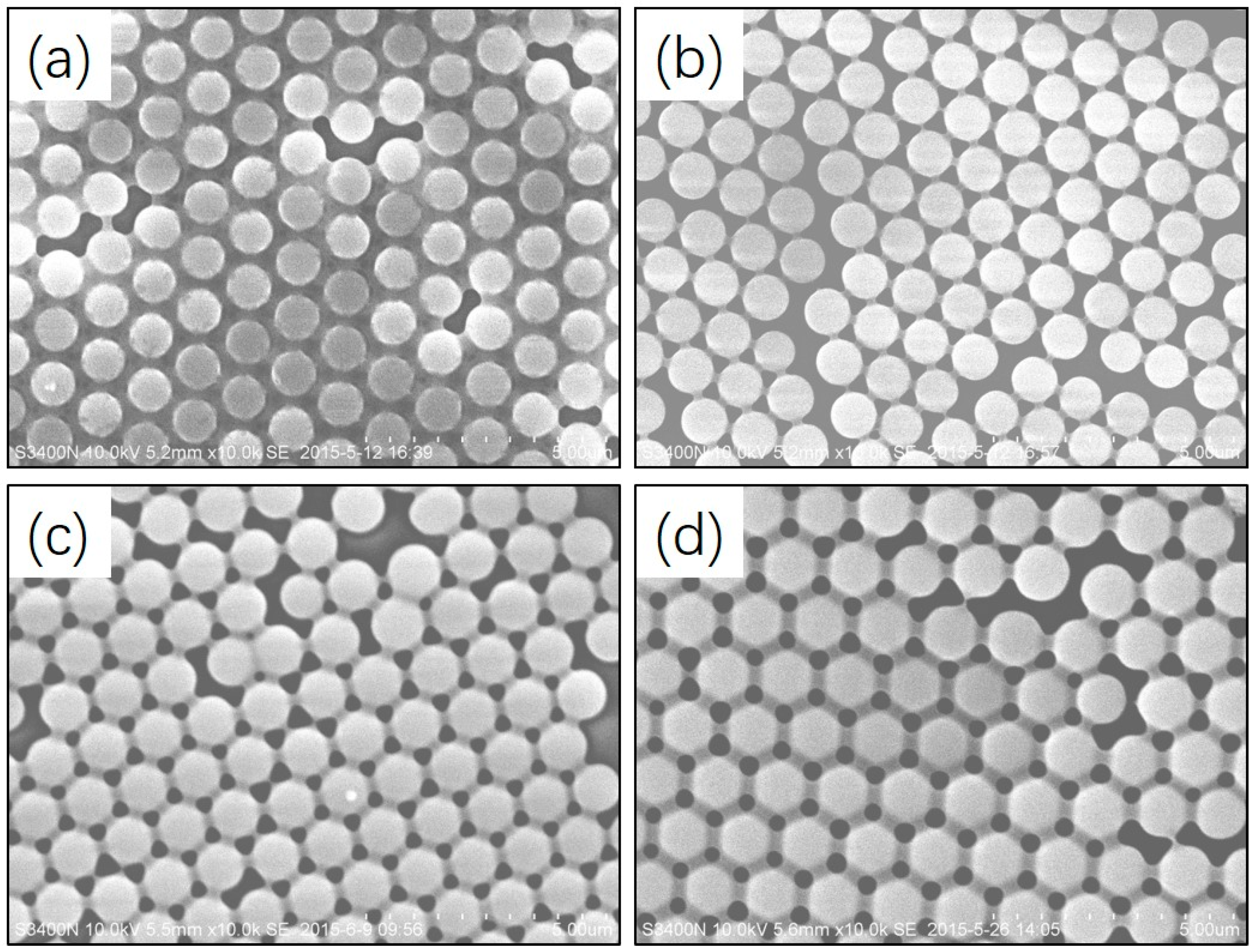
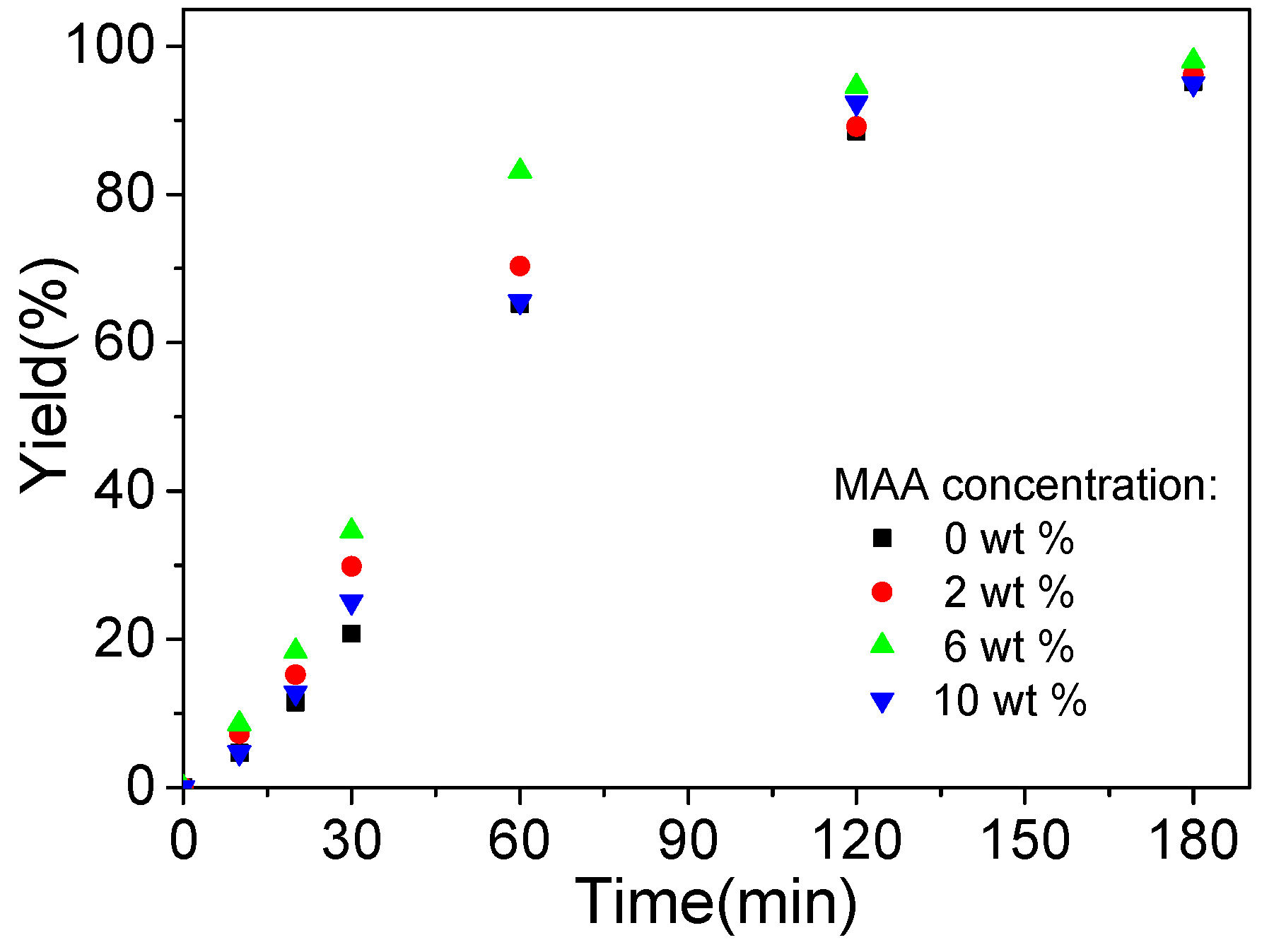
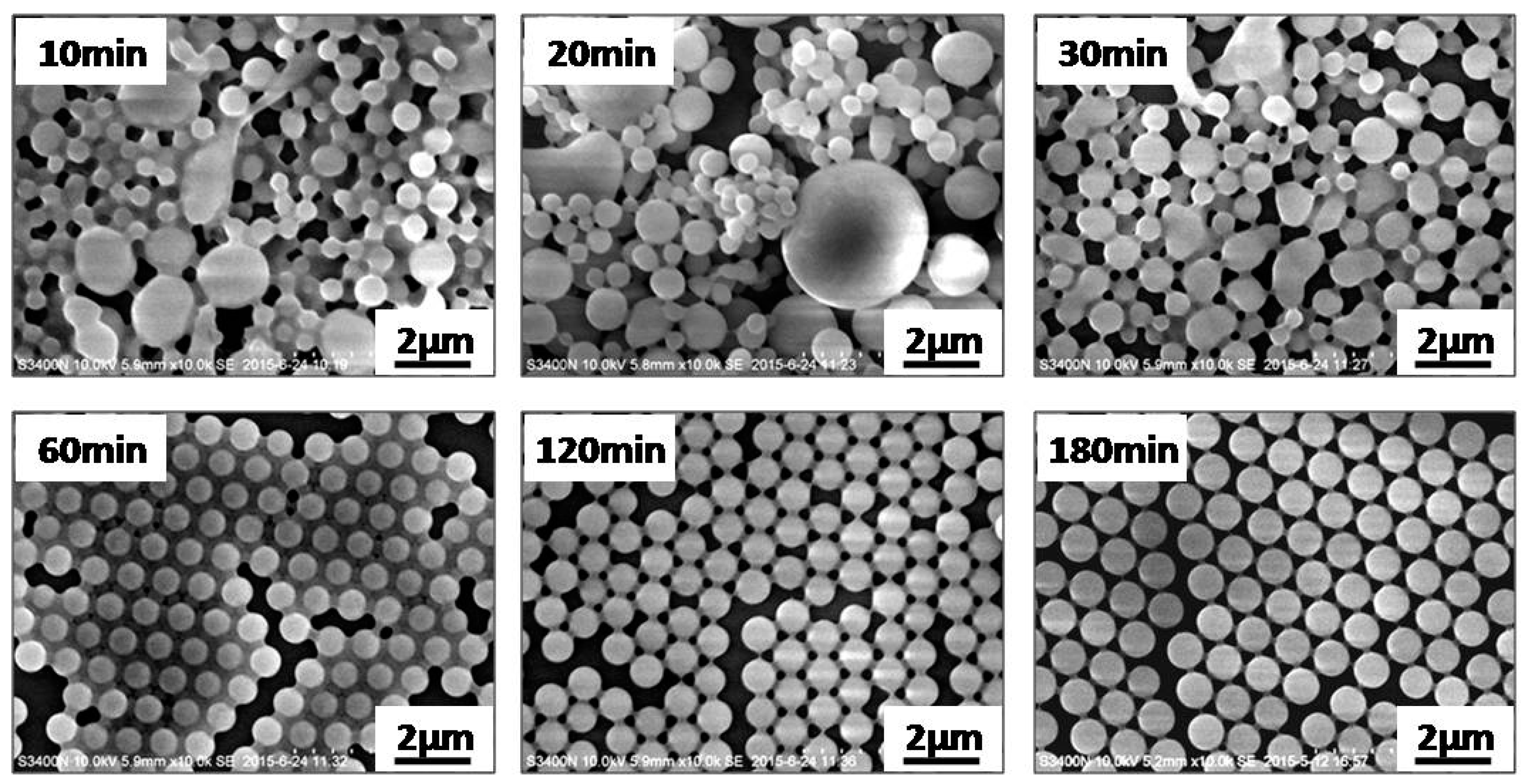
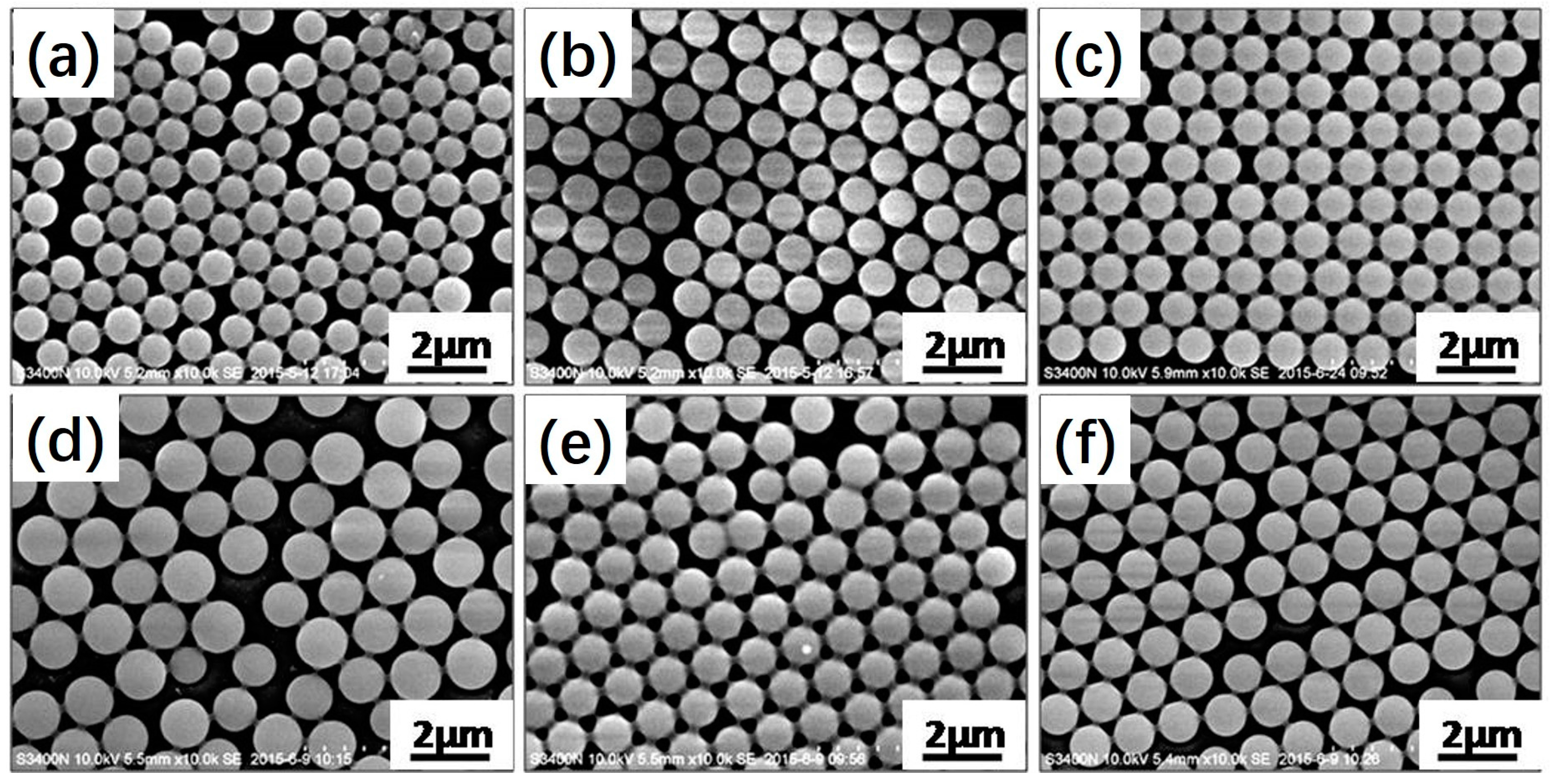


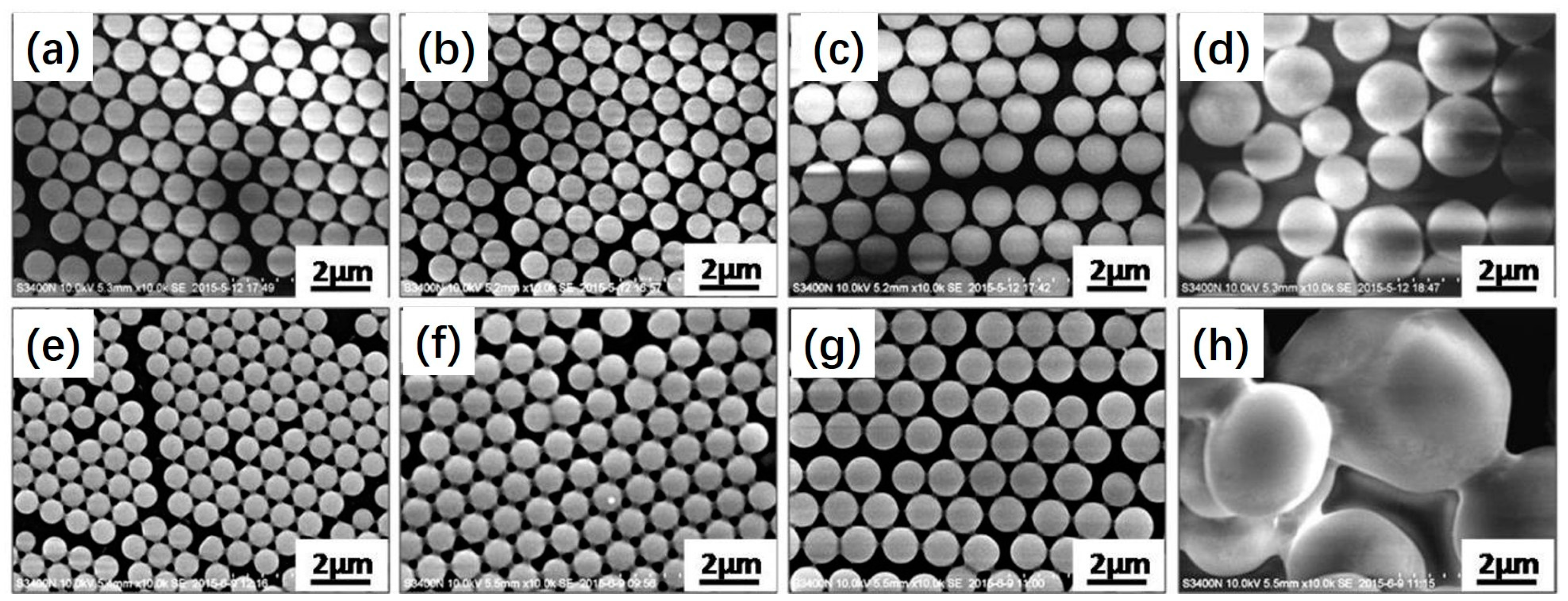
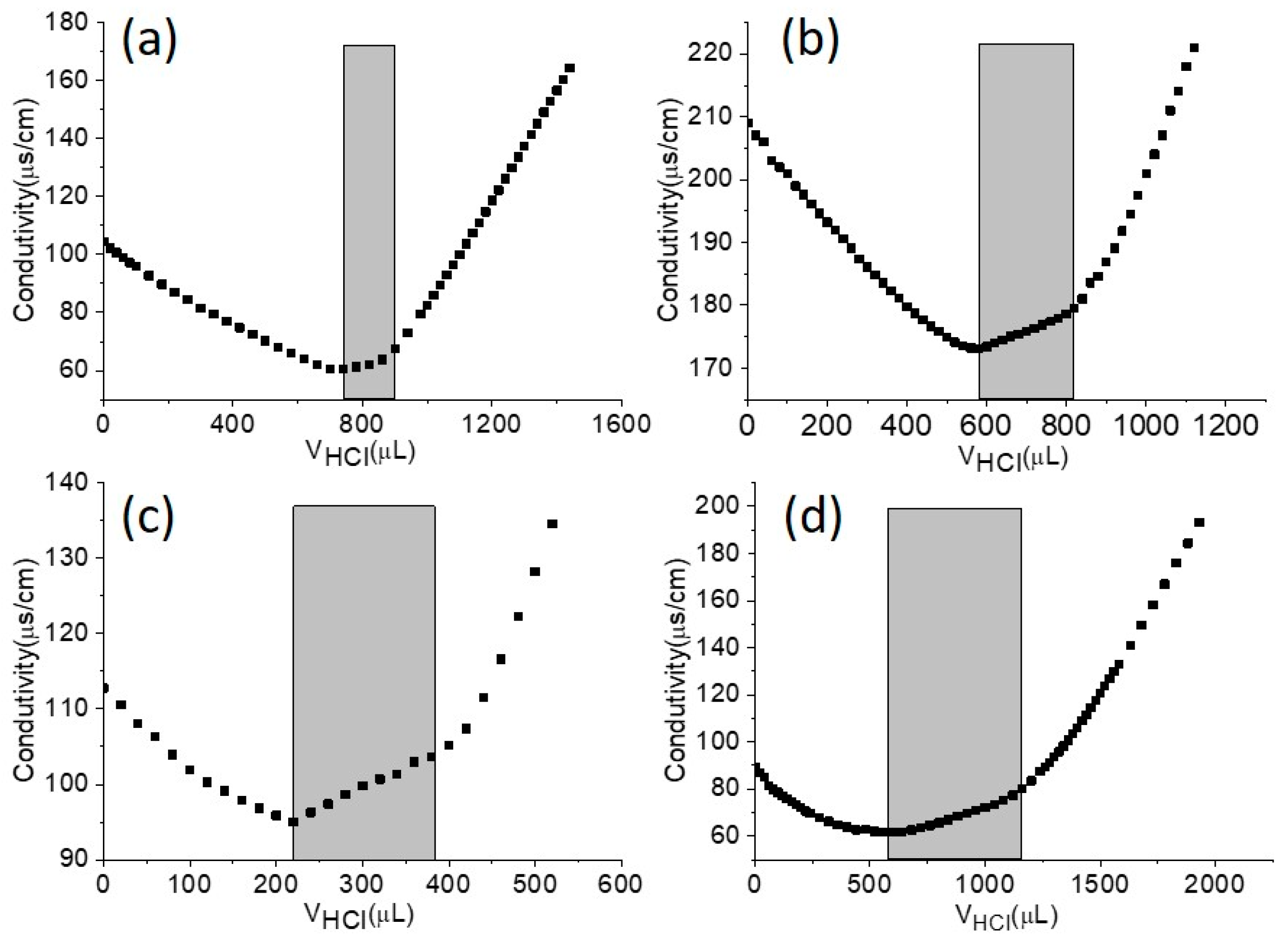
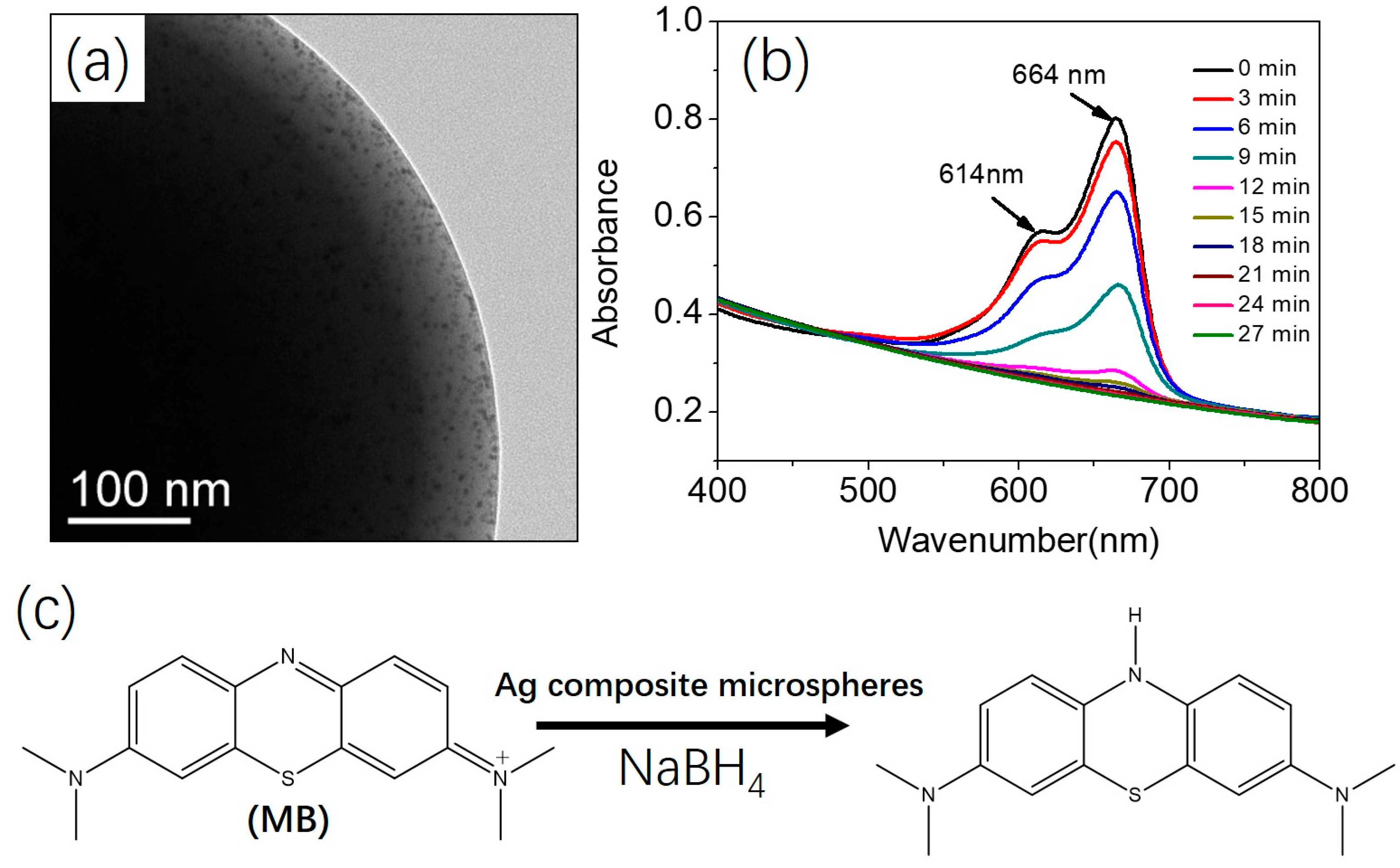
| Entry Number | MMA wt % | MAA wt % | HMPP wt % | BDMAT wt % | PVP wt % | Ethanol/water w/w | dn µm | CV % |
|---|---|---|---|---|---|---|---|---|
| 1 | 10 | 0 | 3 | 0.5 | 15 | 40/60 | 0.92 | 3.1 |
| 2 | 10 | 2 | 3 | 0.5 | 15 | 40/60 | 0.94 | 2.5 |
| 3 | 10 | 6 | 3 | 0.5 | 15 | 40/60 | 1.03 | 2.5 |
| 4 | 10 | 10 | 3 | 0.5 | 15 | 40/60 | 1.09 | 2.4 |
| Entry Number | MMA wt % | MAA wt % | HMPP wt % | BDMAT wt % | PVP wt % | Ethanol/water w/w | dn µm | CV % |
|---|---|---|---|---|---|---|---|---|
| 1 | 10 | 2 | 3 | 0.25 | 15 | 40/60 | 0.95 | 4.2 |
| 2 | 10 | 2 | 3 | 0.50 | 15 | 40/60 | 0.94 | 2.1 |
| 3 | 10 | 2 | 3 | 0.75 | 15 | 40/60 | 0.93 | 2.2 |
| 4 | 10 | 6 | 3 | 0.25 | 15 | 40/60 | 1.21 | 6.5 |
| 5 | 10 | 6 | 3 | 0.50 | 15 | 40/60 | 1.03 | 2.5 |
| 6 | 10 | 6 | 3 | 0.75 | 15 | 40/60 | 1.01 | 2.1 |
| Entry Number | MAA concentration (wt %) | Density of carboxyl groups on the particle surface (nm−2) | Number of carboxyl groups per particle (×106) |
|---|---|---|---|
| 1 | 0 | 0.45 | 1.2 |
| 2 | 2 | 1.48 | 4.1 |
| 3 | 6 | 2.19 | 7.3 |
| 4 | 10 | 4.29 | 16 |
© 2017 by the authors. Licensee MDPI, Basel, Switzerland. This article is an open access article distributed under the terms and conditions of the Creative Commons Attribution (CC BY) license (http://creativecommons.org/licenses/by/4.0/).
Share and Cite
Tan, J.; Li, X.; He, J.; Xu, Q.; Zhang, Y.; Dai, X.; Yu, L.; Zeng, R.; Zhang, L. Carboxyl-Functionalized Polymeric Microspheres Prepared by One-Stage Photoinitiated RAFT Dispersion Polymerization. Polymers 2017, 9, 681. https://doi.org/10.3390/polym9120681
Tan J, Li X, He J, Xu Q, Zhang Y, Dai X, Yu L, Zeng R, Zhang L. Carboxyl-Functionalized Polymeric Microspheres Prepared by One-Stage Photoinitiated RAFT Dispersion Polymerization. Polymers. 2017; 9(12):681. https://doi.org/10.3390/polym9120681
Chicago/Turabian StyleTan, Jianbo, Xueliang Li, Jun He, Qin Xu, Yuxuan Zhang, Xiaocong Dai, Liangliang Yu, Ruiming Zeng, and Li Zhang. 2017. "Carboxyl-Functionalized Polymeric Microspheres Prepared by One-Stage Photoinitiated RAFT Dispersion Polymerization" Polymers 9, no. 12: 681. https://doi.org/10.3390/polym9120681





